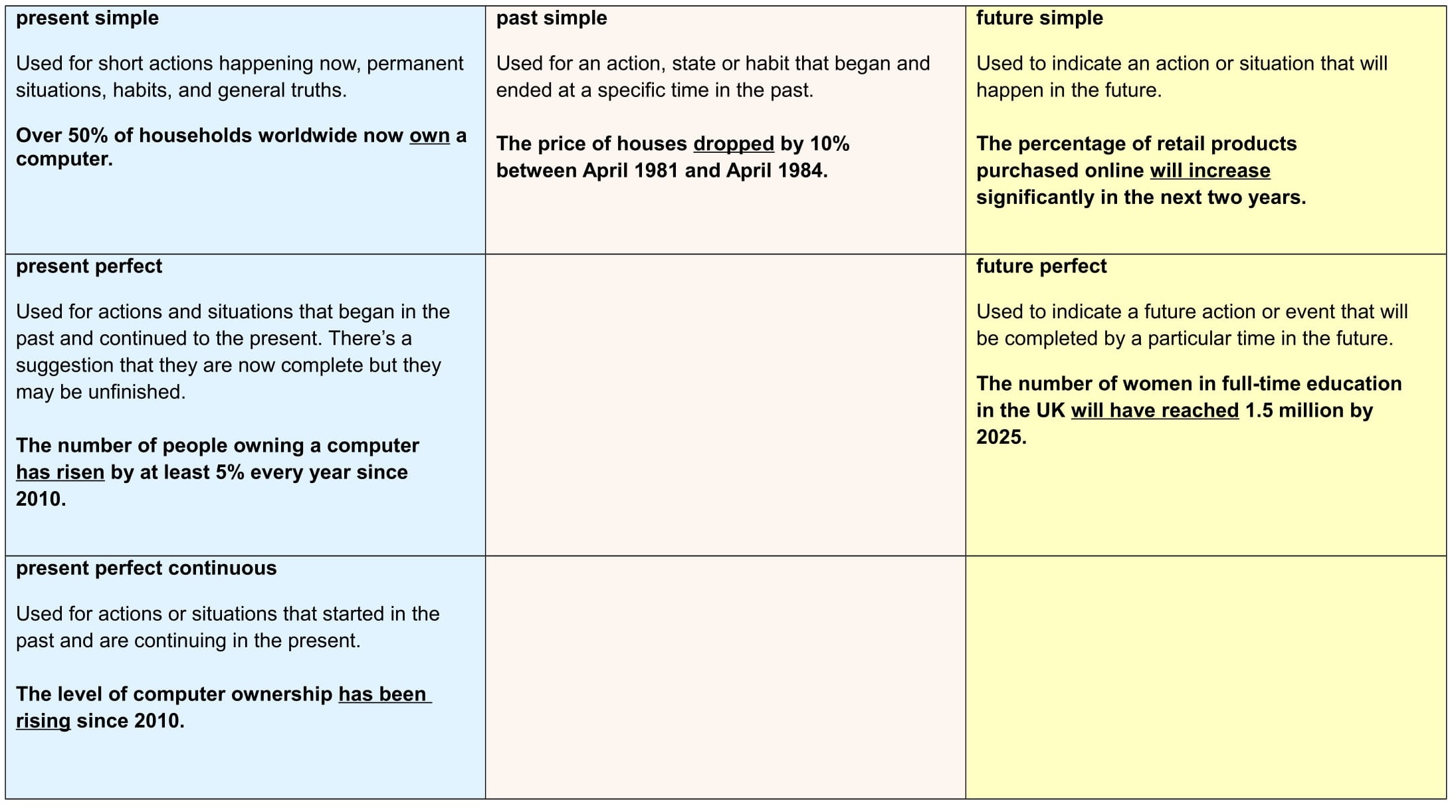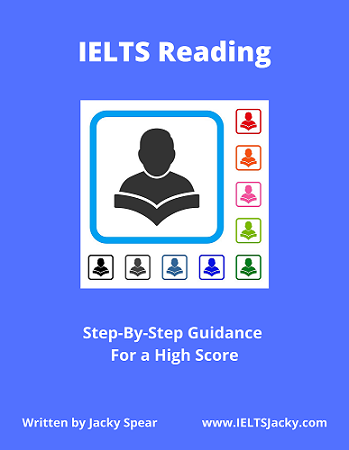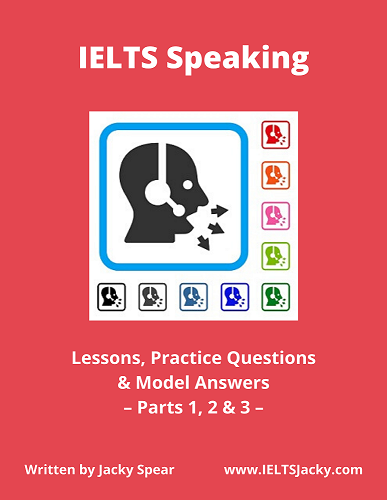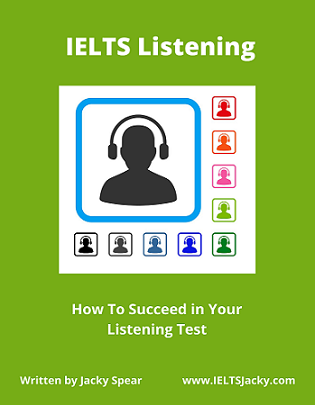Writing IELTS Task 1
– Grammar for Academic Task 1 Essays –
For Writing IELTS Task 1 essays, you are required to describe the detail in a chart, graph, table, map or diagram, most especially, to record changes in data.
This will involve:
- Describing trends
- Describing increases and decreases
- Making comparisons
To do this, you will need to use particular sentence structures and these are one of the things we’ll be learning about in this lesson.
We’ll also be looking at common Task 1 verb tenses and other elements of grammar that frequently cause problems for students.
Here's an overview of the lesson:
1) Verb tenses
2) Key sentence structures
3) 2 Common grammatical errors
1) Verb Tenses
The choice of which tense to use will be determined by whether or not the graphic contains dates and, if it does, whether the dates are in the past or the future.
Follow these guidelines:
- No date – use the present tense
- Dates in the past – use the past tense
- Dates in the future – use the future tense
The tenses you are most likely to need are:
– Present tense – present simple, present perfect or present perfect continuous
– Past tense – past simple
– Future tense – future simple or the future perfect
The table below gives explanations of these verb tenses and examples from Task 1 essays.
Common Writing IELTS Task 1 Verbs

Most graphics will require you to compare data from two or more time periods, for example, past and present or present and future predictions, so you will need to use a range of different tenses in your essay, as appropriate.
The key word in the sentence above is ‘appropriate’. Whilst you will gain marks for using a good range of tenses in your Writing IELTS Task 1 essay, you should never do so just to show that you know many different tenses. Only use the tense that is 100% correct for expressing a specific piece of information. It is accuracy that the examiner is looking for.
2) Key Sentence Structures
The first two steps of writing a great Academic Task 1 essay are to:
- Analyse the question
- Identify the main features
I cover these tasks in detail in the lesson on How To Understand & Analyse Task 1 Questions.
Once you’ve done this, you'll understand what you’re required write about. It will be one or more of these things:
- Describe trends
- Describe increases and decreases
- Make comparisons
There are specific sentence structures that you can use for each and these are what we’re going to look at next.
How to Describe Trends
The two most useful grammatical structures for describing trends are:
1) Noun phrase + verb + adverb
For example,
The number of unemployed women fell significantly.
2) There + be + adjective + in + noun phrase
For example:
There was a dramatic improvement in the percentage of people in employment.
How to Describe Increases and Decreases
The two most useful grammatical structures for describing increases and decreases are:
1) Noun phrase + verb + adverb
For example,
The popularity of social media climbed steadily.
2) There + be + noun + in + noun phrase
For example,
There was a fluctuation in university applications.
There is now a swimming pool in the location of the old factory.
How to Make Comparisons
Useful vocabulary for making comparisons includes:
more
most
high (er) (est)
large (er) (est)
less
least
few (er) (est)
low (er) (est)
small (er) (est)
These words can be used to form many different sentence structures useful for making comparisons, such as.
1) More/fewer/less + noun + than
For example,
More teenagers play computer games than a sport.
2) Most/least + adjective
For example,
The most common childhood illness in 1979 was chickenpox.
3) More/less + adjective + than
For example,
Cruises were more popular than beach holidays in 2012.
4) High/low/few -er + than
For example,
A lower number of teenagers play a sport than play computer games.
5) High/low/large/small -est
For example,
The largest proportion of immigrants came from Mexico.
These sentence structures are valuable tools for getting high marks for your Writing IELTS Task 1 essay, so practice using them.
3) 2 Common Grammatical Errors
For many students, two aspects of grammar that are a particular problem are:
- Prepositions
- Articles
Prepositions
There are two specific prepositions that you will probably use numerous times in your Task 1 essay when reporting change – ‘in’ and ‘of’. They are easy to get wrong.
Follow this general rule:
- When stating the specific value of the change (number, amount, percentage etc.) – use ‘of’.
- When stating what has changed – use ‘in’.
For example:
- An increase of 20%.
- An increase in the number of over 60’s taking exercise classes.
- A drop of almost a half.
- A drop in house prices.
- An improvement of 45 units per week.
- An improvement in retail sales from April to June.
‘Of’ is also used after a value. You will probably want to use proportional values in your Task 1 essay so here are some examples.
- a small percentage of
- just under a quarter of
- exactly a half of
- roughly three quarters of
- a significant majority of
- a high number of
You'll find lots more vocabulary for expressing proportional values in Writing IELTS Task 1 essays on this page: Vocabulary for Task 1 Academic Essays
Another preposition to learn is ‘between’ which you will need to make comparisons. For example,
The price of houses went into sharp decline between 1980 and 1985 but increased significantly from 1986 to 1990.
Articles
Many languages do not have articles, and native speakers of those languages can find it a huge challenge to remember to use them.
In English, there are three articles – the, a, and an. Each is used in specific instances.
1) With singular and plural nouns:
- Use the before singular and plural nouns when the noun is a specific thing. For example,
The bar graph illustrates how many male and female students were studying full-time and part-time in Britain during the years 1970/1971, 1980/1 and 1990/1.
- Use a or an before a singular noun or noun phrase when the noun is non-specific and could be any one of a group or type.
- Use a before a noun or noun phrase beginning with a consonant. Use an before a noun or noun phrase beginning with a vowel.
For example,
Less than 30% of the population took a foreign holiday between 1975 and 1985.
There was an upward trend in families taking an annual holiday abroad after 1990.
2) Noun combinations:
Also, use a/an before adjective singular noun combinations such as these from our preposition list:
- a small percentage of
- an insignificant minority of
- a high number of
The key to improving your grammar is to know your weaknesses and focus on these as you practice and when you check your work in the exam.
Want to watch and listen to this lesson on Writing IELTS Task 1?
Click on this video.
Like this page?
Writing IELTS Task 1 (Academic) – All Lessons
IELTS Academic Writing – A summary of the test including important facts, test format & assessment.
Academic Writing Task 1 – The format, the 7 question types & sample questions, assessment & marking criteria. All the key information you need to know.
Understanding Task 1 Questions – How to quickly and easily analyse and understand IELTS Writing Task 2 questions.
How To Plan a Task 1 Essay – Discover 3 reasons why you must plan, the 4 simple steps of essay planning and learn a simple 4 part essay structure.
Vocabulary for Task 1 Essays – Learn key vocabulary for a high-scoring essay. Word lists & a downloadable PDF.
Grammar for Task 1 Essays – Essential grammar for Task 1 Academic essays including, verb tenses, key sentence structures, articles & prepositions.
The 7 Question Types:
Click the links below for a step-by-step lesson on each type of Task 1 question.







